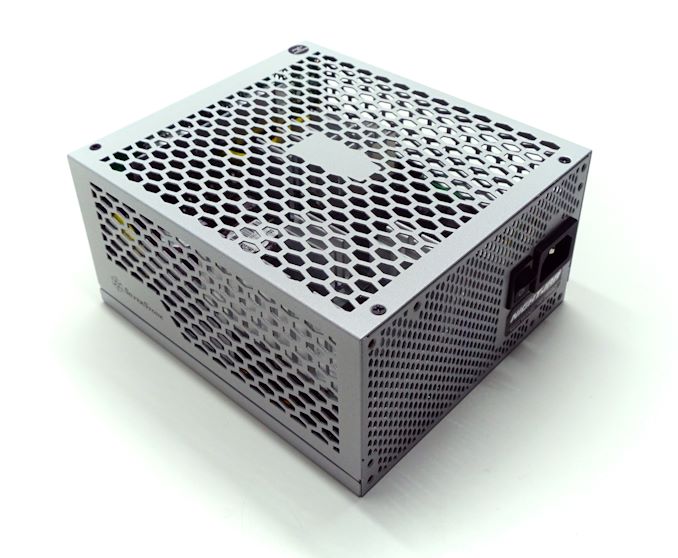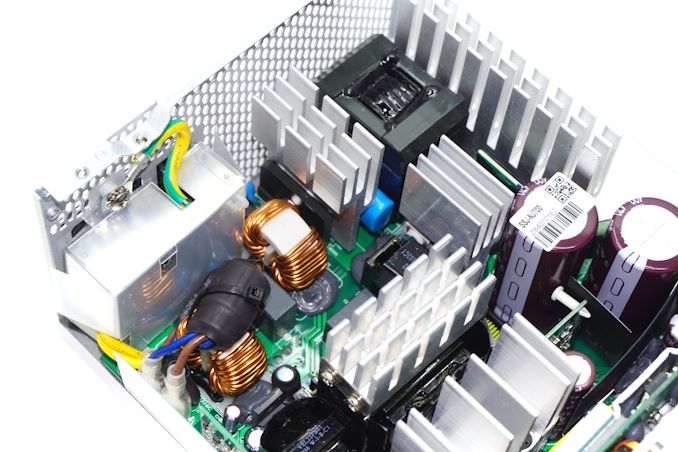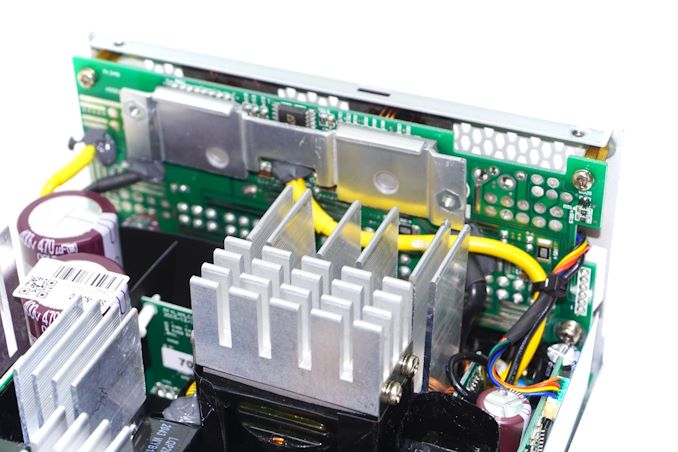The SilverStone NightJar NJ700 Passive PSU Review: Silent Excellence
by E. Fylladitakis on November 29, 2021 8:00 AM EST- Posted in
- Cases/Cooling/PSUs
- PSUs
- SilverStone
- Passive Cooling
Power Supply Quality
As part of our testing, we also check output parameters are within specifications, as well as voltage ripple and line noise.
| Main Output | ||||||||
| Load (Watts) | 141.38 W | 352.97 W | 528.19 W | 703.06 W | ||||
| Load (Percent) | 20.2% | 50.42% | 75.46% | 100.44% | ||||
| Amperes | Volts | Amperes | Volts | Amperes | Volts | Amperes | Volts | |
| 3.3 V | 1.8 | 3.41 | 4.49 | 3.41 | 6.74 | 3.4 | 8.99 | 3.39 |
| 5 V | 1.8 | 5.09 | 4.49 | 5.09 | 6.74 | 5.08 | 8.99 | 5.07 |
| 12 V | 10.42 | 12.1 | 26.06 | 12.08 | 39.09 | 12.05 | 52.12 | 12.03 |
| Line | Regulation (20% to 100% load) |
Voltage Ripple (mV) | |||||
| 20% Load | 50% Load | 75% Load | 100% Load | CL1 12V |
CL2 3.3V + 5V |
||
| 3.3V | 0.75% | 12 | 12 | 14 | 16 | 14 | 12 |
| 5V | 0.5% | 8 | 8 | 10 | 16 | 8 | 12 |
| 12V | 0.6% | 6 | 8 | 8 | 12 | 8 | 12 |
The power quality figures that we received while testing the SilverStone NJ700 inside our hotbox were astounding. We recorded a maximum voltage ripple of 12 mV on the 12V line at 100% load, an incredible power quality figure by any comparison. Voltage regulation also is very tight on the 12V line, staying lower than 0.6% across the nominal output range. The secondary 3.3V and 5V rails are a bit less well filtered, with the voltage ripple reaching 16 mV on both rails under maximum load. Otherwise, the secondary lines are just as tightly regulated, at around 0.5% for both the 3.3V and 5V rails.
Conclusion
SilverStone is greatly focused on the development of high-performance living room entertainment PCs, which goes in tandem with the marketing of ultra-quiet PSUs. The Nightjar NJ700 is a statement product designed both to lure in enthusiasts that will not mind the hefty price tag and to outdo the company’s main competitors.
The OEM behind the Nightjar NJ700 is SeaSonic, perhaps the most reputable top-tier PC PSU OEM. On top of that, the NJ700 is based on what is currently SeaSonic’s best platform. We found only top-tier components inside the Nightjar NJ700, ranging from critical parts down to insignificant filtering capacitors. The developer of this PSU spared no expense and that showed during our testing, when the Nightjar NJ700, a PSU that lacks any form of active cooling, was operating unaffected inside our hotbox and with virtually no change in its performance. SilverStone covers the Nightjar NJ700 with a five-year warranty, which is sufficient, yet strange when the OEM markets the same platform with a 12-year warranty.
Although the platform that the Nightjar NJ700 is analog and relatively basic by today’s standards, the designer of this PSU managed to get ridiculous performance figures out of it. The Nightjar NJ700 comes with an 80Plus Titanium certification tag and it honors it, delivering exceptionally high energy conversion efficiency even when the load is very low. Efficiency is not the only thing that the NJ700 excels on, as its power quality figures also are astounding. Despite its lack of active cooling, heat has practically no effect on the unit’s electrical performance either. All in all, the overall performance of the Nightjar NJ700 is world-class.
With all of that said, when using a passively cooled PSU, there are certain implications that need to be considered. The major point that is the fact that the thermal losses of the PSU will be released inside the system itself, whereas typical, active-cooled PSUs would exhaust most of that thermal energy to the outside of the case. This means that the system itself will get hotter and may require better cooling in order to sustain its overall performance. In this case, the high power output of the NJ700 translates to significant thermal losses when the unit is heavily loaded – regardless of its very high efficiency, there will be more than 35 Watts of thermal energy released to the environment. This will probably not be a problem with modern systems that are built with efficiency in mind, but the specifics of this must be considered and weighted by the system’s builder. After all, it would not make any sense to use a passively cooled PSU only to replace it by another noise source, such as additional case fans.
SilverStone’s choice to market the Nightjar NJ700 could not have been easy. On one hand, the nature of the product aligns with the company profile and their efforts to develop top-performance living room gaming systems. On the other hand, SilverStone has to compete with the OEM of the NJ700, the legendary SeaSonic, as they also market the same platform under their own brand. Practically no other company offers direct competition to the passively cooled NJ700 right now, meaning that its success largely depends on how well its $308 retail price and overall availability fare in comparison to SeaSonic’s Prime Fanless TX-700. That, in conjunction with the strangely significantly shorter warranty length, can be a very complicated subject for SilverStone’s marketing department.













46 Comments
View All Comments
Oxford Guy - Monday, December 27, 2021 - link
I tracked down a review of Seasonic PSUs (SS-1050XP3 & SS-1200XP3) from this site for those claiming fans are no problem in PSUs. The first red flag is the lifespan of the fan:'Seasonic went with a San Ace 9S1212H403 120mm fan in both of their newest models.
The life expectancy of this fan is 40,000 hours, a rather mediocre rating for similar devices, translating to about 4.5 years of 24/7 use at 60°C, albeit this rating also is for a free, unobstructed air path (zero static pressure, max airflow).'
4.5 years is a lot less than infinite, since a fanless PSU doesn't have a fan lifespan issue.
Then, we get to the noise, which is a far far cry from 'silent', even in the cold tests:
SS-1050XP3 results, cold test (decibels at the specified wattage):
'The 120mm fan can be clearly heard at just 40% load and its speed climbs rapidly as the load increases, surpassing even 50dB(A) at very high loads. At such noise levels, the Platinum SS-1050XP3 can be clearly heard from rooms away.'
400 — 32
500 — 36
600 — 38
700 — 42
800 — 46
900 — 48
1000 — 50
1050 — 51
SS-1050XP3 results, hot test:
200 — 34
300 — 37
400 — 39
500 — 44
600 — 46
700 — 49
800 — 51
900 — 53
1000 — 55
1050 — 55.5
I guess I was being too kind by talking about the concern being a PSU that's loud enough to be heard from rooms away. Ear-splitting is apparently another tier here:
'The behavior of the cooling system remains similar with the PSU inside our hot box, with the exception that the fan is even more aggressive, starting at just 20% load and with its speed climbing rapidly as the load increases. At 50% load, under such conditions, the Seasonic Platinum SS-1050XP3 already is a loud PSU, with the sound pressure reaching ear-splitting levels at >80% load.'
SS-1200XP3 cold test:
600 — 39
700 — 41
800 — 44
900 — 47
1000 — 49
1100 — 52
1200 — 52
SS-1200XP3 hot test:
300 — 37
350 — 39
400 — 40
500 — 43
600 — 46
700 — 48
800 — 51
900 — 52
1000 — 54
1100 — 56
1200 — 56
PSUs like those sell fanless units to people like me.
Oxford Guy - Monday, December 27, 2021 - link
Sound levels are from 1 metre away. Forgot to mention that.Wrs - Tuesday, December 28, 2021 - link
This is silly. Not only are these 5 year old designs, but can you explain how someone worried about noise would be drawing 1000W? The PSU has a fan to cool ~120W, but what's cooling the 1000W? If I were super worried about noise, like using a PC in a broadcast studio without mic noise cancellation, I would probably get a system of no more than 250W typical, with a 650W+ hybrid PSU where the fan doesn't even spin at 250W. Effectively fanless in production, turns on during emergency/off hour loads to save the PSU.I'm not worried one bit about fan life expectancy these days. It's trivial to find a start-stop fan PSU. Mine from 11.5 years ago is ball bearing and fully start-stop, though that was rare back then. These days mainstream FDB is used with hysteresis. Remember there's capacitor life expectancy in a PSU and mobo. For every 10C delta, expect a doubling or halving of life. A PSU intake is not going to be 60C, which is scalding hot. A modern case has the PSU draw air straight from ambient
Oxford Guy - Tuesday, December 28, 2021 - link
'This is silly.'I'm amazed you're still at it.
Wrs - Tuesday, December 28, 2021 - link
Side note. Human speech typically runs 50dB at home, 60dB in public. I'd hope neither is ear-splitting!Here's a PSU that measures 20dB at 1300W. The review is almost 4 years old, but the unit was well ahead of its time, close to the pinnacle of efficient design, you could say. Uses technologies still not commonplace, especially GaN FETS. https://www.techpowerup.com/review/corsair-ax1600i...
Oxford Guy - Tuesday, December 28, 2021 - link
Even quieter is a fanless unit.